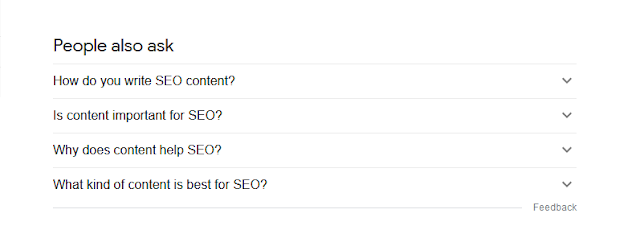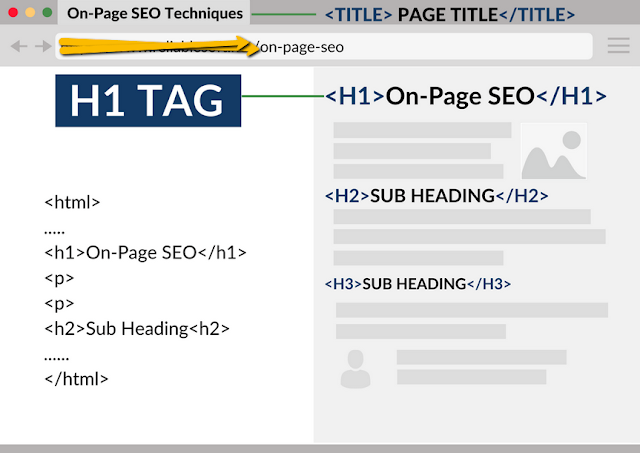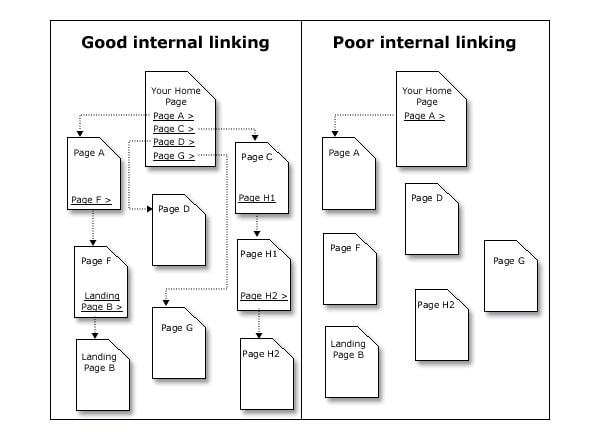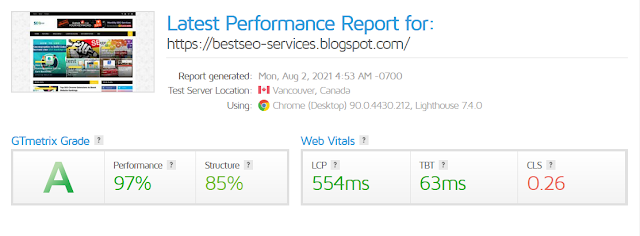On-Page SEO Techniques 2021 - On-page SEO is among the most significant processes you should use for achieving greater rankings inside a search engine’s organic results and running effective Search engine optimization campaigns.
An internet site is the focus of SEO processes and when it isn't correctly enhanced for search engines like google and users, you minimize your odds of generating traffic from search engines like google.
Within this publish you’ll learn everything there's to understand about On-Page SEO Techniques 2021. Try this advice any time you create a new publish and enhance your search engine rankings.
- What is On-Page SEO?
- On-Page SEO Techniques
- On-Page SEO Checklist
- Is On-Page SEO More Important Than Off-Page SEO?
What is On-Page SEO?
On-page SEO (sometimes known as ‘on-site SEO’), is the procedure of optimizing the information of the website for search engines like google. The best objective of On-Page SEO Techniques 2021 would be to speak the ‘search engines’ language’ which help internet search engine crawlers comprehend the meaning and context of the pages.
Why is on-page SEO important?
On-Page SEO Techniques 2021 is essential since it provides search engines like google with numerous signals to assist them to know very well what your articles is all about.
Throughout the indexing and ranking processes, search engines like google attempt to affiliate webpages with keywords and check terms users enter in the search engine.
It’s through on-page SEO elements that you could guide them regarding which keywords you would like your website to position.
Additionally, it's known as ‘on-page’ because any optimization changes designed to a website lead to some better consumer experience.
On-site Search engine optimization is really a subset of Search engine optimization. Check out the diagram below and see how On-Page SEO Techniques 2021 intercepts with technical Search engine optimization and Off-Page SEO.
What is SEO?
Search Engine Optimization is really a general term which includes all you need to do in order to enhance your website’s ranking positions within the top search engines like google.
Including optimizing your site for that crawling and indexing phase (that’s technical Search engine optimization). Optimization settings you are able to affect your website and content (that’s on-page SEO) and methods you should use outdoors the limitations from the website (that’s off-page SEO).
What is Off-Page SEO?
Off-page Search engine optimization is all about backlink building along with other signals you are able to share with search engines like google to convince them concerning the quality and effectiveness of the website.
It is due to advertising techniques outdoors the limitations of the website.
11 On-Page SEO Techniques for Higher Rankings
Since the idea about SEO and the significance of on-page SEO is justified, let’s proceed to the sensible part.
Many people can argue there are more On-Page SEO Techniques 2021 and not just 11, but fundamental essentials most significant you are able to apply aimed at your website today and rapidly improve your Search engine optimization.
Here is a summary of all on-page SEO techniques:
- Publish high-quality content
- Optimize page titles and meta descriptions
- Optimize page content
- Headings and content formatting
- SEO Images and other multimedia elements
- URL optimization
- Internal links
- External links
- Page loading speed
- Mobile-friendliness
- Comments and on-page SEO
1. Publish High-Quality Content
When confronted with Search engine optimization, you usually have to know the dimensions and following:
An internet site with brilliant content can perform great without or with Search engine optimization. An internet site with bad content won't survive without or with Search engine optimization. An internet site with higher content may become better still with Search engine optimization!
So, what is considered good content? High-quality content has the following characteristics:
Original content (articles, text, images, videos, presentations, infographics, comments, etc.) – No copies or rewrites of existing articles.
Content exclusive for the website - Even when it’s your personal content, for those who have already printed it on another website then it’s harmful to your website (unless of course you specify the canonical tag properly).
Content which includes text elements - Write text to accompany your non-text content. For instance, should you publish videos in your website consider adding a text description too. Should you add images attempt to describe in words exactly what the image is about.
Content that's helpful - Don’t publish content with regard to publishing. Before striking the publish button make certain that what goes live adds value aimed at your website and readers.
Content that's well researched - Users shouldn't read rapidly prepared posts nor do search engines like google. Lengthy content is shown to rank much better than short articles.
Impartial content - If you're covering a particular subject or answering an issue make certain that that which you write is justified so they cover both sites of the story.
Content that satisfies search intent - In addtion characteristics, you have to make certain that the content satisfies looking intent. Before publishing any kind of content in your website you must know which kind of content users need to see for any given search query.
In general, the search intent can be categorized into four types:
- Informational – ‘how many calories in an egg?’
- Navigational – ‘Facebook’
- Transactional – ‘buy coffee maker’
- Commercial -‘best SEO courses’
The simplest way to discover which kind of happy to create is to benefit from Google simply because they already did a fantastic job of being aware of what users like for various searches.
So, the initial step is to visit Google and check for the target keywords. Navigate and thoroughly check out the top ten results. Be aware of products like:
- The type of content
- The level of detail
- How they use images and video
- Page design
Your ultimate goal is by using these details to construct better content. Better within this context means numerous things like:
- More thorough and informative
- Easier to read
- Possibly presenting a different view of the subject that is not already covered by the existing content.
Failure to produce content that satisfies looking intent will ultimately result in lower rankings. Even though you have the ability to rank highly on the internet, this is temporary because Google uses different signals to determine whether users are pleased using the websites proven on top of the outcomes.
So, before attempt considering on-page Search engine optimization, make certain the content you develop is exactly what a Google searcher wants.
2. Optimize Page Titles and Meta Descriptions
They are doing so because they have to know very well what the page is about after which according to additional factors (off-page Search engine optimization, domain authority, competition, etc.), they'll rank your page (for a number of keywords) ready within their index.
A webpage using the title “SEO Strategies for Beginners” is preferable to a webpage using the title “index.html”.
The page title is one of the most important on-page SEO factors.
The most important page title optimization tips are:
Add keywords to the start of your titles on pages - Whenever possible incorporate your target keywords to the start of your page title. This can help search engines like google understand right right from the start what keywords the page is targeting.
That doesn't mean you need to mix the road and begin doing keyword stuffing. If you fail to possess a keyword at the start then it isn't the finish around the globe. Just make certain that the target keyword belongs to the title.
Write short and descriptive titles - A webpage title doesn’t need to be very lengthy. The overall recommendation would be to ensure that it stays below 60 figures since this is the typical quantity of figures displayed by Google within the search engine results.
Include figures and power words - Getting figures within the title in addition to power words like “Ultimate, actionable, amazing, listing, etc.”, make titles more intriguing and this increases their CTR (Click Through Rate).
You don't need to incorporate your domain within the title - There's you don't need to incorporate your website name within the title since this is added instantly by Google. You can use the 60 figures to supply a precise description from the page.
The best for this rule is if you have a powerful brand that individuals can certainly recognize, within this situation, you can look at getting your domain within the title.
Meta Descriptions
The page description is proven around the internet search engine search engines (SERPS). It needs to be descriptive, as much as 200 figures, and different for every page.
It’s your chance to market your page and convince users to click your link and go to your website instead of selecting among the other links.
It ought to be noted that Google doesn't necessarily show the custom meta description, however, many occasions they will use an automatic description when they believe is much more helpful for that searcher.
The most crucial meta description optimization tips are:
Avoid auto-generated descriptions - Despite the fact that Google might not make use of your description, it's usually a finest practice to prevent using auto-generated descriptions that typically don’t seem sensible.
Incorperate your target keyword(s) within the description - Google still highlights looking terms in the description and title so adding your target keywords, makes descriptions more relevant and attractive to the searcher.
3. Optimize Page Content
Content SEO belongs to on-page Search engine optimization and is due to optimizing the particular content for the target keywords.
Before publishing a bit of content (whether this really is text, images, audio, or video), the initial step would be to do your market and keyword research.
This really is necessary to discover what search phrases users are keying in looking box and make content that may satisfy their intent.
Once you choose your target keywords, you need to make a list of related keywords (also known as LSI keywords), longtail keywords, and employ them inside your titles, descriptions, headings, and page content.
Why? Since with the development of Rank Brain, Search algorithms have grown to be more intelligent and besides keyword relevancy in content, they're also searching for subject relevancy.
Which means that to make your articles more highly relevant to broad topics, you have to enrich your articles with LSI keywords.
There are numerous ways to find out what keywords are thought by Google to apply to your target keywords.
The fastest and easiest strategy is to benefit from three features supplied by Google: Google suggests, People also request and Related Searches.
Google suggest
When you begin typing a question in the search engines search, you're given a summary of possible phrases to make use of during your search. They are great keyword candidates to say inside your content.
People Also Ask
When you click search, Google shows you the results and among them, a section called “People also ask”. These are good candidates to use in your sub-headings
Related Searches
At the bottom of the search results, Google shows you a list of related searches.
4. Headings and Content Formatting
A website should be properly formatted. See it as as being a study that will require a heading (h1) and subheadings (h2, h3).
The H1 Tag
Each page will require only one H1 tag. If you use WordPress then instantly the title from the page is wrapped into H1 tags.
You can choose to offer the same <title> and <h1> tag or present an alternative title for your heading.
Bear in mind that engines like google display inside the results whatever they enter the title tag rather than the h1 tag.
As far as the other headings are concerned (h2, h3), the things you need to have in mind are the following:
- Avoid using a single word for a heading but make your headings interesting and useful for users that like to skim read an article.
- Use headings hierarchically i.e. the first heading tag is the <h1> and then the <h2> and then <h3>, <h4> etc.
- The subheadings are a great place to use related keywords in your content.
Content Formatting
Do not just throw text on a page but make sure that it is readable.
- Use bold, underline or italics to highlight the important parts of a page.
- Use a good size font (at least 14px).
- Split the text into small paragraphs (max 3-4 lines).
- Use enough spacing between the paragraphs to make the text easier to read.
- Make use of CSS to create sections that stand out and break the text into smaller more manageable parts.
5. Images and Other Multimedia Elements
Images are essential for presentation purposes. They create a webpage more intriguing and simpler to know.
The greatest issues with images are that search engines like google don’t understand them and they increase the loading speed of the page.
Best practices for SEO optimizing images
- Use original images. If you need to use an existing image from the web you need to reference the source.
- Optimize the size of the images – the smaller the size (in bytes) of the image the better.
- Use an ALT tag to describe the image – This helps search engines understand what the image is about.
- Use descriptive filenames – Don’t just name your image ‘image1.jpg’ but try to use descriptive filenames, for example, ‘man-doing-push-ups.jpg’.
- Use a Content Delivery Network – If you have a lot of images on a single page you can use a CDN service that will make your page load faster. In simple terms, your images will be hosted and served by a number of servers and this speeds up the loading process.
6. URL Optimization
Optimizing your URLs is essential for optimum Search engine optimization. It's a double edged sword. Part one is URL optimization and the second reason is the URL structure.
A lasting link (also referred to as a slug) may be the unique Link to each page.
Good URLs ought to be under 255 figures and employ hyphens to ‘-‘ separate the various parts.
Similar to the page title, an Search engine optimization friendly URL is brief, descriptive, and includes your target keyword.
Guidelines for optimizing your URL structure
The URL structure should mimic the particular structure of the website.
Utilize groups - Group your website into groups to assist users and check engines find what they need faster.
It’s like getting a warehouse with a lot of uncategorized products versus a warehouse with the products allotted to a passionate category.
You could have sub-groups too but make an effort to not to talk about two levels. For instance, a great category structure is:
Homepage > Social Networking > Facebook > Article
and never
Homepage > Social Networking > Facebook > How You Can > Article
Give a Breadcrumb menu- A breadcrumb is useful since it enables users to navigate your site inside a structured way given that they always know where they're and just how not even close to the house page.
7. Internal Links
Linking to pages within your site is essential for Search engine optimization because:
It’s like building your personal web
The initial step a internet search engine spider is going to do after they uncover a webpage, would be to stick to the links they find with that page (both internal and exterior links).
So, once they get to your page, should you not have other links inside the text they'll read your page and go.
For those who have links pointing with other pages in your website they'll take individuals into consideration too.
It’s a method to let search engines like google learn about other pages
As described above when search engines like google look for a page with links, they'll go and browse individuals pages too, so this can be used method to tell search engines like google about pages of the website they haven't yet yet discovered.
It’s a method to tell search engines like google which your most significant pages are
Every website has some pages which are more essential than the others. Internal linking is among the methods to pinpoint the most crucial pages by delivering them more internal links.
It’s a method to boost the users invest in your website
A person that's studying your publish is more prone to click a hyperlink for more info in regards to a certain subject thus increasing both time invest in your site, quantity of pages per visit, and reduce the bounce rate.
Best practices for internal linking:
- Don’t use keywords only for your internal links
- Add internal links when they are useful for your reader
- No more than 15 internal links per page (this is my opinion and not based on any research or studies)
- When possible, add the links in the main body of your webpage (not in the footer or sidebar)
8. External Links
An exterior link is really a link pointing to some page outdoors your site i.e. on the different domain. For that site that links out, it’s an exterior link but for the site that receives the hyperlink, it’s a backlink.
We all know that backlinks are essential for Search engine optimization what about exterior links?
Exterior links to related pages help Google determine your page’s subject. Additionally, it shows Google that the page is really a hub of quality info.
Adding exterior links for your content won't directly assist you with Search engine optimization, it isn't a ranking factor but it can benefit you not directly.
You should use exterior links to link to other websites after which send them an email and inform them about this. Webmasters is going to be very happy to know you have associated with them and a great method to begin a conversation. You are able to progressively develop this relationship and finally get backlinks aimed at your website as numerous webmasters could be more prone to return the favor.
Let’s quickly review the best practices to follow when adding external links to your content.
- Link out only when it provides value to the reader.
- Link only to websites you trust.
- Link only to related websites that have unique and original content
- Use the ‘nofollow‘ tag for external links going out to websites you don’t fully trust.
9. Page Loading Speed
Google is investing a lot of money to help make the web faster. In each and every Google, I/O someone will discuss the need for speed as well as their need to range from the fastest websites within their index.
To be able to ‘force’ website proprietors to consider speed into consideration, they've formally added speed among the known ranking factors.
So, we all know without a doubt this website speed is important with regards to Search engine optimization and ranking.
Like a website owner, your work would be to make certain that the website loads as quickly as possible by considering Google’s recommendations. Getting fast-loading websites isn't just great for Search engine optimization however for customer retention and conversions.
10. Mobile Friendliness
Almost 60% from the searches in the search engines are actually originating from cellular devices. Which means that if your site is not mobile-friendly, you're already losing 1 / 2 of the possibility traffic.
What in the event you do?
Like a initial step, make certain that your site is mobile-friendly. Look at your website using the Google mobile friendly oral appliance fix any potential issues.
Go a step further and test out your website on mobile, just like a real user would do, and make certain that things are displayed properly as well as your CTA buttons.
Generally websites having a responsive design, do not have anything to bother with mobile-ambiance.
11. Comments and On-Page SEO
Lots of people think that using the rise of social networking blog comments aren't important, but they're wrong.
Blog surveys are still important. As mentioned by Google’s Gary Illyes, it’s a sign that individuals much like your content and communicate with the page which can definitely improve your SEO.
Users before posting a brand new comment will most most likely browse the existing comments which is an alternate way to boost the time they invest in the page as well as your website.
To help make the best utilization of comments, follow these simple rules:
- Always moderate comments before publishing
- Avoid publishing comments that are too general
- Only approve comments that are relevant to the page content and add value
- Don’t approve comments when users don’t use a real name
- Always reply to comments, this will encourage more people to comment.
On-Page SEO Checklist
For those who have browse the article up up to now, the primary tips are summarized within the listing below.
- Make sure that you understand the difference between on-page SEO and off-page SEO.
- Make sure that your content is original, useful, and well researched.
- Review and optimize your page titles by adding keywords, power words, and numbers.
- Provide a unique meta description for all your pages (include your target keywords).
- Perform keyword research and make sure that your target keywords are part of the title and content.
- Find LSI and related keywords and use them in your headings and content.
- Make sure that your page has only one H1 tag.
- Use headings hierarchically on the page (H1 -> H2 -> H3).
- Beautify your content (use bold, italics, and CSS).
- Optimize your images and other multimedia elements (ALT Text is the most important factor for images).
- Make sure your URLs are SEO Friendly and that your URL Structure mimics your site structure.
- Add internal links to your content.
- Add outbound links to your content (link out to high-quality related websites).
- Make sure that your website loads in less than 3 seconds (both desktop and mobile).
- Make sure that your website is mobile-friendly.
- Encourage comments but only publish comments that make sense.
Conclusion
On-page SEO is essential if you wish to improve your website’s likelihood of turning up within the search engine results.
Optimizing for on-site factors regularly might help enhance your rankings, traffic, and conversions.
















3 Comments
SEO Company Pune
Nice blog!!
Do you want more traffic in your website? Then Adtric, one of the best seo services in Delhi can help you in driving more traffic and generating more leads and sales. With our effective SEO strategy your site will rank higher.
Thanks for sharing with us.
Click to Get Free Guest Posting Site